This article has been in the works for a long time but keeping track of football cleats accurately in today’s era where uniformity is thrown to the wind can be a fool’s errand. Also, the majority of photographs either omit players’ feet or are too far away get a good look at the cleats so I kept pushing the project down the road.
Then, Notre Dame released 1988 throwbacks with curious cleats and I could wait no longer. This history goes out to all of the people who make shoe contact before eye contact.
I. The Beginning
For decades and decades football cleats were no more than glorified work boots HERE with studs on the bottom. In the early years they were brown and as the game progressed in the 20th Century black became more fashionable. By the time of the 1950’s–when color photography changed the way games were viewed for posterity–Notre Dame was a solid black cleat wearing program. For example, you can see this in a 1956 shot HERE of quarterback Paul Hornung.
The first big change I found came in 1959 when Notre Dame players were spotted wearing black SpotBilt cleats with white laces–company logos and lace color changes popped up at the same time which is interesting. SpotBilt was a subsidiary of modern running shoe company Saucony (hence the similar logo) and very popular for a really long time in college football.
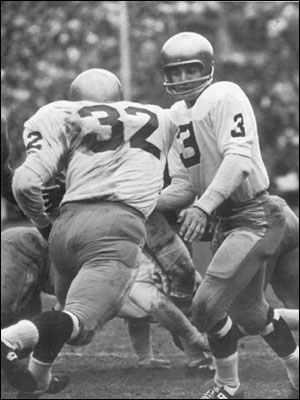
SpotBilt cleats from 1959.
Note: It’s important to understand that for the next 20 years no company held a monopoly on cleats worn by Notre Dame football players. Although SpotBilt and especially Riddell were the two most popular worn by the athletes as the years progressed there was also Spalding, Puma, and Adidas mixed in at any point during a game.
HERE is a tremendous shot of Terry Hanratty from 1966 wearing the standard SpotBilt’s and HERE is a promo shot of Joe Theismann from 1968 in a pair of Riddell cleats.
II. The Modern Era
Thing began to change as the 1970’s ushered in an era of more individual flare combined with the introduction of artificial turf surfaces which automatically forced new footwear options. HERE is a shot from the 1971 Cotton Bowl against Texas featuring Riddell cleats in black with white laces in Notre Dame’s first-ever game on astro turf.
Quarterback Tom Clements was one of the first players to alter his cleats HERE wrapping a bunch of white tape around the middle of his foot. The first player I could identify with full spatted football cleats was running back Al Hunter in 1976 photographed HERE.
The first player I could find in Adidas was running back Eric Penick from 1973 HERE in this beautiful photo. The one constant from the late 50’s through the mid 70’s was black cleats with white laces. When Notre Dame faced Alabama to close out the 1973 National Championship season inside Tulane Stadium’s turf for the Sugar Bowl they did so in those black cleats with white laces. Two years later, while facing Alabama again–this time in the Orange Bowl in Ara Parseghian’s final game with the Irish–the team wore all white cleats HERE for the first time in program history–apparently the Puma turf shoes were very popular.
Beginning with the 1977 season, the Irish switched to white cleats full-time, a trend that would last for the next 9 seasons.
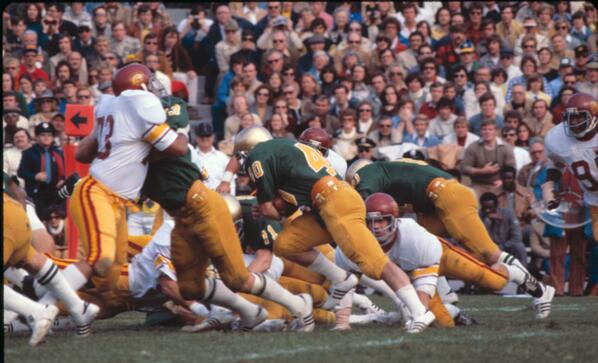
The 1977 “Green Jersey Game” featured white cleats.
That means during the infamous “Green Jersey Game” in which Notre Dame switched into emerald after warmups the team was in white cleats with white laces which also means when the Irish wore these throwbacks in 2007 the black cleats were incorrect.
The late 70’s were an era for most players wearing Adidas cleats. By 1980, Notre Dame had switched to Nike which would last through the 1985 season. During the 1981 Sugar Bowl HERE you can see the Irish in Nike turf cleats while a couple years later in the Faust era you can see similar cleats from the Oregon company HERE.
III. Back to Black
When Lou Holtz was hired in 1986 he made the decision to switch to Adidas, ditch the white for black cleats, and paired them with black laces. HERE is a shot of quarterback Steve Buerelein from 1987 in low top Adidas. When Notre Dame won the National Championship in Holtz’ third year it cemented THIS LOOK as the archetypal championship style.
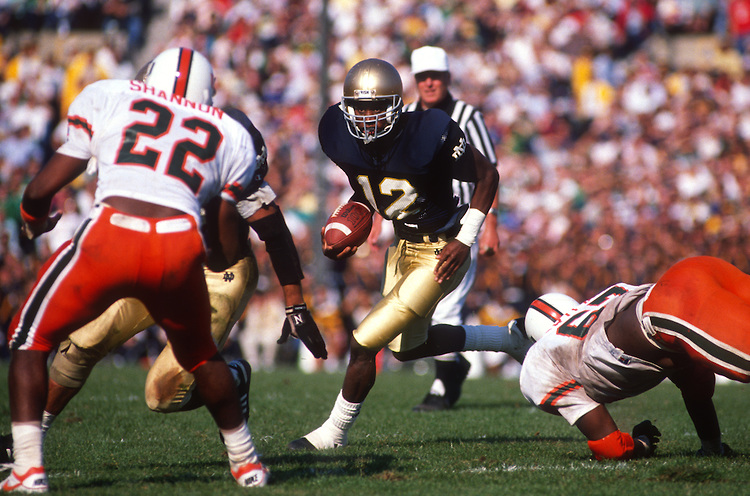
Ricky Watters with the iconic open-calf white spats over black cleats.
Many of the players from the late 80’s and early 90’s would famously drown their black cleats with white spats further creating an iconic look from an era of dominance on the field.
IV. The Vendor Era
The 1990’s exploded the shoe market in the United States and Notre Dame made a switch after 7 years with Adidas to feature Reebok cleats on the football field. It was a controversial move at the time but lasted for 4 full seasons until Lou Holtz retired.
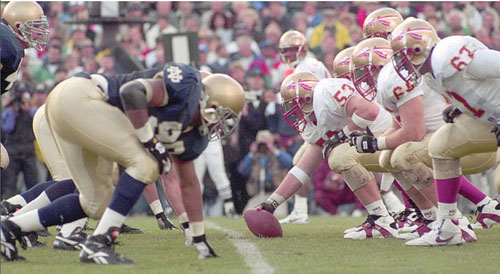
Notre Dame’s last “Game of the Century” featured the team in Reebok cleats.
When the Bob Davie era began in 1997 the Irish switched back to Adidas HERE and would remain with the 3 Stripes brand for the next 17 years, signing a vendor contract extension twice, as the money involved in these deals became increasingly lucrative. Although the styles changed slightly over the years, the black cleats/black laces combo from Adidas brought about remarkable stability in Notre Dame’s look HERE well into the 21st Century.
V. The Wild West
When Brian Kelly took over in 2010 the Irish remained in the same look as the immediate past including black Adidas cleats with black laces. It wasn’t until 2011 when the flood gates opened to a brand new world of football cleat repertoire at Notre Dame. Here’s the full breakdown:
2011
In week two the Irish wore 1959 throwbacks at Michigan HERE which included white cleats with green accents, marking the first game in white cleats since November 30, 1985 a span of 306 games. Of course, as we’ve shown above these cleats were not era specific as the ’59 team wore black. Notre Dame would wear these same white cleats again later in the season during the Shamrock Series HERE versus Maryland.
The Irish finished 2011 in the Champs Sports Bowl against Florida State HERE wearing new blue/gold/white striped cleats.
2012
When Notre Dame opened the 2012 season in Dublin against Navy they sported the same cleats as the previous year’s bowl game except in Irish flag colors.
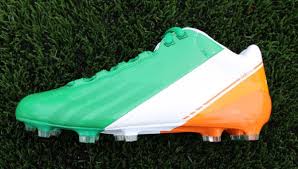
The Irish flag cleats from 2012 in Dublin.
The most lasting change in 2012 when the team arrived Stateside was switching to primarily blue cleats with gold and white accents. In the last 7 seasons, the Irish have not returned to black cleats at all. Some of the players HERE even swapped out the blue laces for white laces.
2013
The following season, Notre Dame continued the primarily blue with gold accent cleats for both home and away games. The only change came in the Dallas Shamrock Series game against Arizona State HERE in which the Irish wore green cleats with gold trim.
2014
Notre Dame continued the use of blue and gold cleats in 2014 but when they played Purdue in Indianapolis for the Shamrock Series an all-gold cleat HERE was debuted. The team would go on to wear these all-gold cleats in all of the road games for this season.
2015
The all-gold cleats were a big enough hit to be used in all 2015 games. The only two exceptions were a home game against Navy in which both teams wore the same white “Mutual Respect” cleats and the Shamrock Series game at Fenway Park HERE that saw the Irish return to green cleats with gold accents.
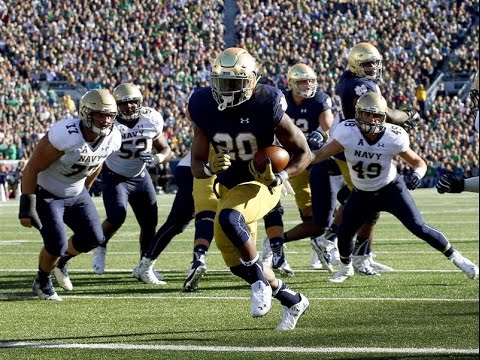
White cleats were worn at home for the first time since November 23, 1985.
You may notice not all players wore the Shamrock Series cleats at Fenway and kept their all-gold cleats. This has become a theme in recent years with a lot of mixing colorways.
2016
For home games in 2016 the Irish went to a primary gold cleat with blue accents and laces HERE. The program made a change for road games by debuting a primarily white cleat HERE with gold accents and laces. In this year’s Shamrock Series game in San Antonio the team went with an unusual army green cleat HERE with gold trim to match their uniforms.
2017
The home and away colorways remained the same from 2017 to 2018 although there are some exceptions. I first caught a silver/gray offering HERE as well as the first pure white cleat HERE during this season. For the Rockne Heritage game the team wore throwback all-brown cleats in a nod to the 1920’s era.
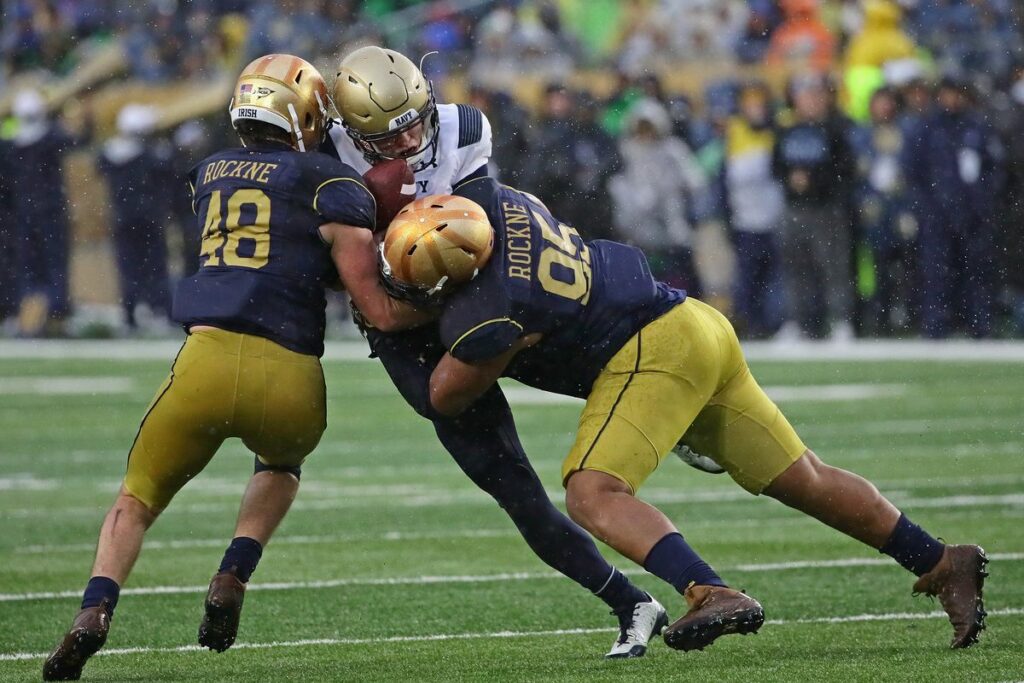
The special one-off Rockne Heritage uniforms featuring brown cleats.
2018
Last year saw the Irish wear primarily white cleats during all games during the regular season, with one exception. For the most part, the players wore white laces or sometimes blue laces like HERE. In the past couple seasons we’ve seen variations of white, silver, gray, and a subtle mixed patterns HERE that Jalen Elliott especially liked to wear last year.
The lone exception during the regular season was the Shamrock Series game in New York City featuring Yankees themed HERE cleats.
For the playoff semi-final against Clemson the Irish wore “Rush 4 Gold” uniforms that featured green cleats with gold accents as seen in this article’s main photo.
2019
Judging by what the players are wearing during August practices there doesn’t appear to be too many changes for the footwear in 2019.
Cleats from 2019 fall practices.
It looks like 80% or more are either wearing all-white cleats or white cleats with blue accents and blue laces. This likely means these primary white cleats are going to be worn for both home and away games again in 2019. There’s also a smattering of silver/gray/white mixed cleats, players wearing the playoff green cleats, and I’ve even seen a couple all-black cleats (same as last off-season, Cole Kmet wears them a lot) that don’t appear to be for game use.
Of course, the Irish will be wearing 1988 throwback uniforms against Boston College on Senior Day that will feature black cleats with white laces HERE that aren’t era-correct as we’ve covered that style was only worn from the late 50’s through 1976. The metallic silver sole isn’t either but hey if the shoe fits, wear it.
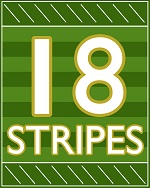
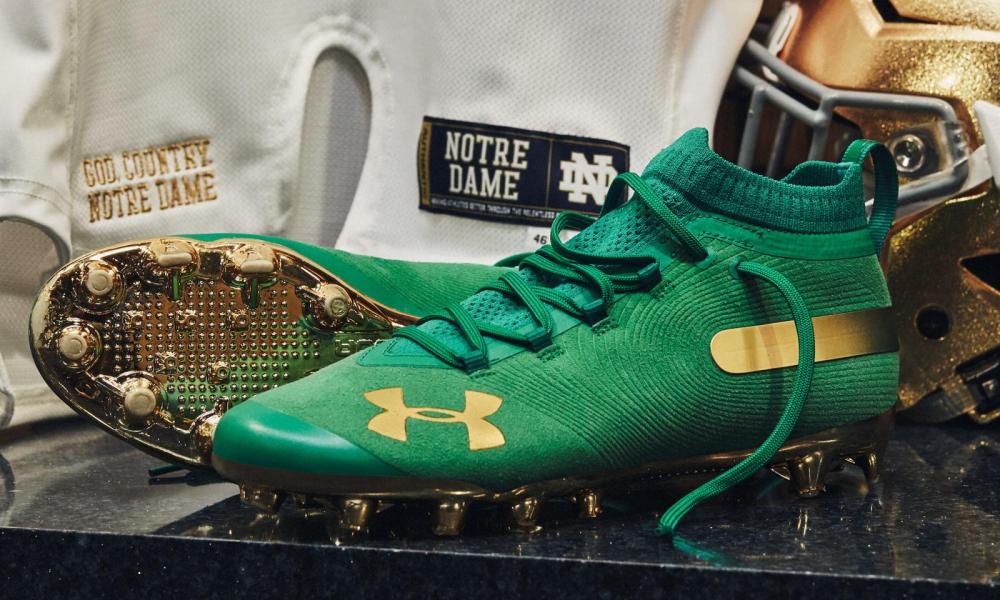

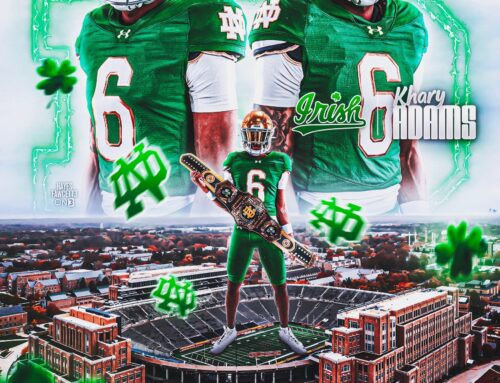

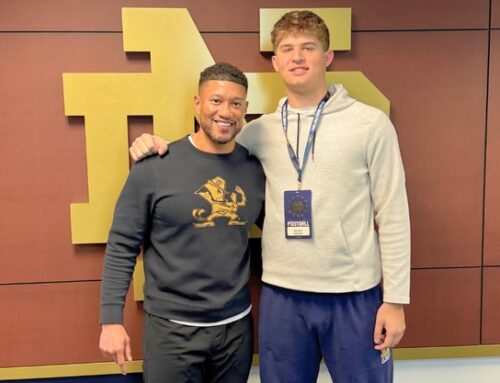
I really enjoyed this piece. Great work. I gotta say that, if I can’t have spats, black cleats/white laces are my favorite combo.
Did you pick up the “Irish” detail on the heel tab in the Faust-era turf cleat example? I dig that.
If I’m reading this right, and I’d like to think that I am, ND’s decline in the mid-90s was not, in fact, due to changes to recruiting rules, the ousting of Vinny Cerrato or a decline in Holtz’s coaching as much as this:
“The 1990’s exploded the shoe market in the United States and Notre Dame made a switch after 7 years with Adidas to feature Reebok cleats on the football field. It was a controversial move at the time but lasted for 4 full seasons until Lou Holtz retired.”
When it comes to Reebok, Rod Tidwell had it right.
Now, we are partnered up with the 21st century Reebok!
Harsh but fair.
You had to post a photo of the play that knocked Hanratty out of the 66′ MSU game? That’s Bubba (95)closing in for the “tremendous shot”. (nice wording)
That, I did not know.
What cleats would you have the team wear now if you had (ahem) sole authority over such a decision? Taking into account program history, changing brand landscape in athletic footwear, aesthetics, uniforms, etc.
Great question!
For the warm weather games I’d have the team in black cleats (Nike, of course) with white calf-length socks and spats.
For colder weather, black cleats with white/blue pro-style socks and white spats. I think we can agree the Clausen-to-Tate duo derived at least 15% more power in 2009 from this Hall of Fame look.
I’d be okay with rotating in all white cleats/socks for the occasional road game and all black cleats/socks for a home game here and there.
By the way, a lot of trainers think spats are really dangerous and I agree. But damn, they look good.
Joined this convo late, sorry guys. My two cents, the blue leggings w/ white socks, black adidas, w/ black laces is the most iconic look. Never been a fan of white cleats but understand the historical significance. What saddens me the most is the lack of team uniformity at ND nowadays. Perfect example was in their Sun Bowl win against Oregon State. Some guys had what appears to be the traditional blue leggings on others did not. Some had one single blue leg sleeve on. Just all over the place!